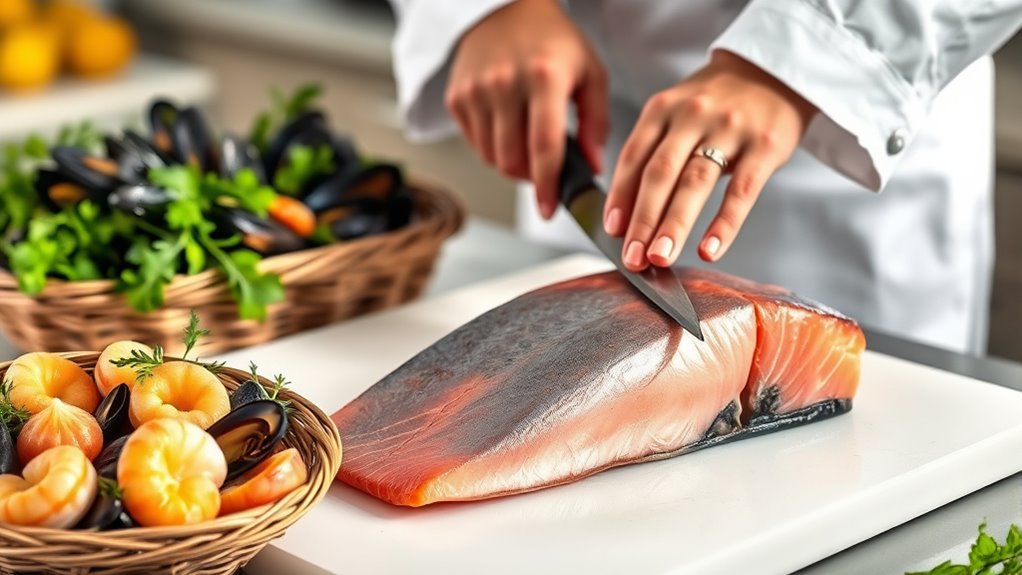When you choose certified fish and shellfish, you’re supporting responsible fishing and farming practices that protect our oceans and guarantee healthy fish populations. Look for labels like MSC or ASC when shopping to easily identify sustainable options. These certifications mean the seafood is sourced with minimal environmental impact and fair labor standards. By making these conscious choices, you help preserve marine ecosystems for future generations—and if you keep exploring, you’ll discover more ways to enjoy sustainable seafood.
Key Takeaways
- Look for certified labels like MSC and ASC when purchasing fish and shellfish to ensure sustainability.
- Choose seafood from reputable sources that follow responsible fishing and aquaculture practices.
- Prioritize seasonal and locally caught options to reduce environmental impact and support sustainable fisheries.
- Incorporate sustainable seafood into recipes to help promote ocean health and conservation efforts.
- Educate yourself on sustainable choices to make informed decisions that support marine ecosystem preservation.

Have you ever wondered whether your seafood choices can make a difference? When you buy fish and shellfish, you’re not just satisfying your taste buds—you’re also influencing the health of our oceans and communities. Many consumers overlook the importance of understanding aquaculture impacts and how consumer labeling can guide responsible choices. Aquaculture, or fish farming, has grown rapidly to meet global demand, but it’s not without consequences. Some farms can lead to habitat destruction, water pollution, and the spread of disease, which threaten wild fish populations and marine ecosystems. By being aware of aquaculture impacts, you can choose seafood that aligns with sustainable practices, helping to reduce environmental harm. Recognizing the significance of certification labels can further assist you in making environmentally responsible choices.
Your seafood choices impact ocean health—choose responsibly to support sustainable aquaculture and protect marine ecosystems.
Consumer labeling plays a crucial role in this process. Labels like the Marine Stewardship Council (MSC) certification or Aquaculture Stewardship Council (ASC) indicate that the seafood was sourced responsibly. These labels are more than just marketing tools—they’re a quick way for you to identify products that meet strict environmental and social standards. When you see a certified label on a package, it means the fish or shellfish was farmed or caught with minimal environmental footprint, fair labor practices, and adherence to sustainable management. Paying attention to consumer labeling empowers you to make informed decisions that support sustainable fishery and aquaculture practices, ensuring healthier oceans for future generations.
Frequently Asked Questions
How Can I Identify Certified Seafood in Stores?
You can identify certified seafood in stores by checking the seafood labels carefully. Look for labels that display certification program logos, such as MSC, ASC, or BAP. These logos indicate that the fish or shellfish meets sustainability standards. Always verify the label to confirm it’s genuine and up-to-date. By doing this, you’re supporting responsible fishing practices and making eco-friendly choices for your meals.
Are There Affordable Sustainable Seafood Options Available?
Think of choosing sustainable seafood as finding hidden treasure on a map. You’ll discover affordable options that are budget-friendly choices, helping you do good for the planet without overspending. Look for sales, frozen fish, or canned options labeled with eco-certifications. These affordable options make it easy to enjoy delicious, sustainable seafood while keeping your wallet happy. With a little hunting, you’ll find plenty of sustainable treasures ready to cook!
How Does Sustainable Fishing Impact Local Communities?
Sustainable fishing positively impacts local communities by supporting community economic development and strengthening marine conservation efforts. When you choose sustainably caught seafood, you help make certain fish populations remain healthy, which sustains livelihoods for fishermen and local businesses. This responsible approach promotes long-term economic stability and preserves marine ecosystems for future generations. By making mindful choices, you contribute directly to the resilience of these communities and the health of our oceans.
Can Frozen Certified Seafood Be as Nutritious as Fresh?
Frozen certified seafood is like a treasure chest—just as nutritious as fresh when stored properly. You’ll find that frozen versus fresh seafood often retains more nutrients because it’s flash-frozen shortly after harvest, locking in freshness and flavor. This means you don’t sacrifice nutrient retention for convenience. So, when choosing seafood, don’t overlook frozen options—they can be just as nutritious and sustainable, making your meal both healthy and eco-friendly.
What Are Common Misconceptions About Sustainable Seafood?
You might think sustainable seafood is complicated, but common misconceptions include overfishing myths and eco label confusion. Many believe all fish is overfished, but responsible choices help support healthy populations. Eco labels like MSC or ASC guide you, yet some think they’re confusing or unreliable. In reality, these labels guarantee your seafood is responsibly sourced, making it easier for you to enjoy delicious, eco-friendly options without worry.
Conclusion
By choosing certified fish and shellfish, you support sustainable fishing practices, protect ocean ecosystems, and guarantee healthy seafood for future generations. You make mindful decisions, reduce environmental impact, and promote responsible consumption. You embrace ethical choices, celebrate marine biodiversity, and enjoy delicious, responsibly sourced seafood. You become part of a movement that values sustainability, conservation, and respect for our oceans—because every small action counts toward a healthier planet and a brighter future.









